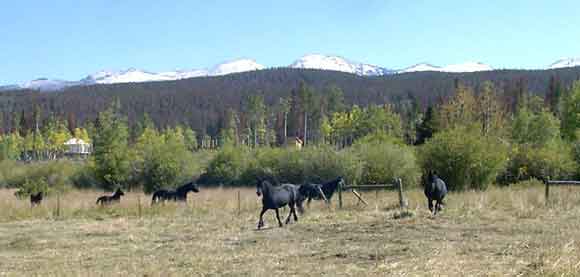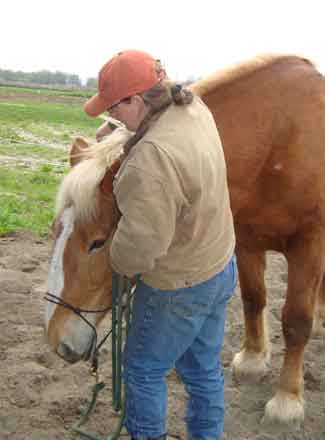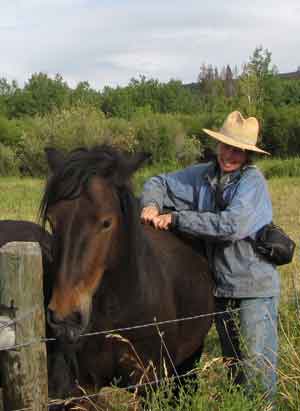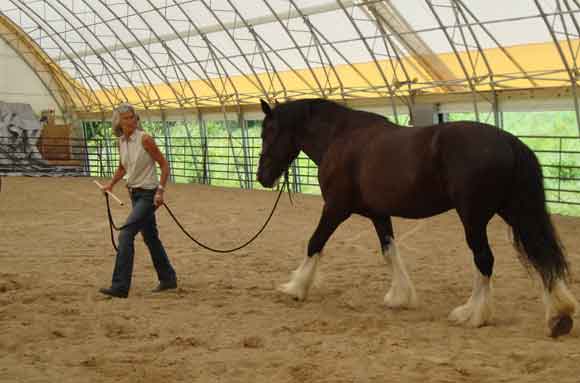Daily Opportunities for Creating Safe Horses

a measure of the relationship we have with them.
So far, Bob’s study has been mostly about routine, dayto- day things like getting horses to come when called, feeding, haltering, leading, and grooming. “Doc’s instilling in me the importance of this stuff.” How can general husbandry activities improve our horses’ performance in harness? Ultimately, says Doc, our horses’ performance is determined by the relationship we have with them. We are a working unit, and the success of our performance can only be measured by the quality of the relationship we have with each other.
Doc says, “If we don’t have the relationship with these animals as we are with them every day -- as we feed, as we halter, as we take them from place to place -- we are sure as the dickens not going to have it when we have them in harness. If we don’t have this safety and cooperation on the ground, when we’re right next to them, how can we have it when we’re eight or 10 feet behind them, connected with skinny little lines?”
Doc continues, “You don’t have to be a professional trainer to start this. You don’t have to be a professional trainer to take it as far as you can possibly imagine going with it. You just have to take advantage of every moment with your horse as a training opportunity and do it in ways that the horse inherently understands. I have students all over the country who are taking advantage of these daily mundane opportunities, people who never thought of themselves as trainers, people who planned to send their horses to trainers, but who are taking advantage of these opportunities to create calm respectful horses. Those same people are ultimately teaching those horses to drive themselves. Most people that I deal with think of ‘training’ as putting their horse in school, in a lesson, an event, or a session, that’s specifically designed for training. But I am training every moment I’m around these horses. I don’t even like to call it training. Really, for me, it’s about relationship, it’s about daily interaction. It’s about how we make use of opportunities to shape and reshape behavior.”
- You can trust me.
- You need to respect me.
- I’m the leader. I’m going to ask you to do things, and I expect you to do them. I’m going to ask you not to do things, and I expect you not to do them.

Bob’s first task each day is to give feed to Doc’s retired Clydesdale mare. “I mix Misty’s senior feed at the house then go down to the pasture. She knows the routine and can get pretty excited about her grain.” Doc’s routine requires Misty to be respectful, including putting her head down for the nosebag to be attached. Next, Bob feeds Doc’s mother/daughter team of Suffolks. “They have to move away from the feed tire and behave themselves. They have to give me both their body and their minds. I keep my eyes on them, and use a plastic bag on a stick if I have to. I’ll also use words or shake my fingers, but with eye contact alone they are usually good. There’s a subtle difference between them giving me their bodies and them giving me both their bodies and their minds. They can be standing the right distance away, but their attention is locked on what I’m doing rather than looking in the opposite direction, looking relaxed, maybe with their heads down, licking and chewing. It’s only when they give me both their minds and their bodies that I fork their hay into the tire.”
Bob is learning what respect looks like with Doc’s horses and then is training his own horses to be respectful at feeding time, too. “I’m teaching them to come on a whistle. I started by using rewards – giving them pellets when they came to the gate. My mare comes first, and I have her stop a half dozen feet away with the verbal ‘whoa’ and a physical gesture such as putting my hand up. Then I toss her a pellet where she can see it. I’ve now done this often enough that they still come even if there’s not a pellet. The technique works -- the power of intermittent reward. I haven’t noticed after it’s intermittent that there’s any different response.”
Doc says, “Everybody feeds their horses, one way or another. What I’m trying to emphasize is the opportunities we have for shaping behavior, getting compliance, and getting respect. They are so numerous, it’s amazing. They’re so subtle that a lot of people don’t understand how important and how powerful they can be. Regardless of how you feed, the principles are the same. The body language of horses is the same. They ask us questions. Can I have my feed now? The answer is yes or no. If the behavior they’re exhibiting is acceptable – they’re standing away politely and waiting -- then the answer can be yes. If they’re mugging us and grabbing bites of hay out of our arms, the answer should have been no long before that started to happen.”
Doc continues, “If we learn their language, if we learn horse behavior, if we consciously give them that first bite of feed when the behavior is acceptable and good and safe, then we are training in a positive way. If we reinforce positive behavior, respect and good manners every day when we feed our horses, imagine how much better their behavior is going to become over time.”
Doc concludes, “All great trainers use food rewards properly in their training processes. But it’s so easy to use food rewards in ways that encourage the wrong behavior. Unless people are very conscious and diligent and educated about the use of food as a reward, they can get into terrible trouble and produce dangerous horses or horse behavior that is completely unacceptable. It’s far better to never use food as a reward than to use it improperly.”
Doc continues, “I want my horse to come to me rather than me go to them. I don’t walk straight up to them. Instead, when I arrive, I start by scratching their withers. I don’t go to their head first. I don’t rush to get the halter on. The way I approach should minimize the pressure I’m putting on them. Also, I carry the halter and lead rope the same way every time because it makes them more comfortable. As many things as I can do consistently, the less chance the horse is going to be concerned about something. When there are new things in a training situation, the more I can do that’s the same, the more chances I’ll have of succeeding at what I want to do.”
Finally, when it is time to halter, begin with slowly and calming looping the halter around the horse’s neck. When the horse is comfortable in that position, then ask them to lower their head. Finally dip the halter onto their nose. Being haltered at this point should be a non-event because it’s been a slow, friendly progression.
Doc’s work-study student Bob adds, “Unhaltering is as good an example as haltering. It’s the reverse process, they need to drop their head, take the halter off and then they can go. The other day, I unhaltered my gelding Jake, and he bolted away. I was committed to getting him again and not ending on that note. I wanted to make it better. To catch him again without him fleeing from me in a pretty large space, I approached using the body language that Doc has taught me in the round pen. When I noticed his eye contact on me, for instance, I bowed my head and backed up a step, avoiding eye contact. Then I approached slowly, walked up to his shoulder, scratched his withers and was able to put the halter on. Then I asked him to lower his head. I put my left hand on his nose. I petted his nose, petted between his ears, then slowly let the halter fall, petted him, and he didn’t move. The slowness that I didn’t do the first time really paid off. It felt great.” Knowing our horses’ favorite spots to be scratched is a key opportunity for enhancing our relationship and ultimately improving our work together.
“To begin, at the most fundamental level, if a horse makes a move without my lead, then I’m not really the leader. I have to manage their feet. If they move without me asking, even if it’s just a single foot, I put them back where they were. I put them in that place for a particular reason, and they don’t get to move unless I ask them to. This lesson alone can really help horses think differently about the person they’re with.
“Then when it is time to move, if I’m going to be the leader, I need to lead from a very specific position with the horse, at least initially. Until we get great skill, we need to lead from in front. If I’m the leader, he doesn’t pass me and he doesn’t lag. If I speed up, he speeds up. When I get ready to stop, I slow down, turn and face him. My chest square to the horse means stop, stay back or go away. Students often say, ‘I feel unsafe walking in front. I’m afraid my horse will run over me.’ I respond, ‘Not if you’re truly the leader they won’t.’
“I try to use body language first to get my horse to follow me and to stop. The idea is to use the rope as little as possible, if at all. For instance, I will arc to the side to ask my horse to follow me, using my body language first. If that doesn’t work, then I use pressure on the lead rope. We always want to start with a soft, light message, whether it’s body language, voice, or physical cues, and then increase, increase, increase until the horse chooses to respond. If we start with the softest message first, we’re giving the horse the choice to respond to that softness. If I jerk on my horse’s head as the first thing to get them to follow me, I’m reducing the chances that I can get them to respond to my body language or voice first.
“You’ll notice that I work with these animals on a fairly long rope. I do not hold near the snap, for instance, or even the first few feet away. If I hold the horse close, then I’m physically controlling the horse, and if I physically control the horse all the time, he is not going to learn to voluntarily follow the leader.”
If we’re working our horses, there is a certain amount of grooming we do, whether it’s brushing off dust and chaff, picking out feet, or combing our horses’ coats until they shine. One opportunity not to be missed during grooming sessions is finding and making use of your horse’s sweet spots. Doc says, “If you don’t know your horse’s sweet spots, your horse’s favorite spots to be groomed and itched, then you’re missing a big opportunity.

a key opportunity for enhancing our relationship and
ultimately improving our work together.
Tying our horses up and letting them stand is a very important training tool. It teaches patience, it teaches them to stay in one spot, and it lets them work out their anxiety and energy. Doc says, “From a veterinary standpoint, we’ve learned some very important things about tying horses. First, we should always tie to a hitch point that is withers height or higher. If a horse pulls back when he’s tied low, he can cause himself serious injury. Second, all young horses – less than 31/2 to 4 for saddle horses, 4 to 41/2 for drafts -- should be tied with something elastic because if they set back, they can do serious damage to immature tissues. There’s only one bungee tie that I will use for this purpose.” (For the bungee tie that Doc Hammill uses and recommends, see his website: www.dochammill.com.)
Doc’s work-study student Bob makes this observation: “There’s a big difference between my Jewel and Doc’s Ann in the round pen right now. Ann is really talking to him, asking questions and understanding his answers. On the other hand, Doc spent 40 minutes with Jewel; this horse has some endurance. She’s holding on to being able to think for herself even though she’s been a good horse and, for the most part, is very well behaved. She stands quietly, she’s not antsy, but she’s been allowed to get away with things. Now she’s met Doc, and he’s speaking horse to her, and she’s holding onto that dominant mare-ish behavior. She’s starting to submit in a big way. She’ll be safer in the human world when she does. I keep asking Doc how can it be that this horse has been a pretty good horse? He’s told me she’s been able to go along with the program, giving her body but not always all of her mind. Now she’s got to give both consistently for her to be safe and reliable.”
“People often ask me,” says Doc, “what’s the secret to having horses that are well behaved? It’s not sending them to the trainer. It’s not having formal training sessions. The thing that makes more difference than anything else in safe, willing, comfortable, responsive horses is what we do day to day, every moment we’re around them. Why would they suddenly behave in the ways we want when we have them in harness if they’re not reminded and required to behave in ways that are acceptable, safe, and cooperative on a day-to-day basis. That’s the secret.”

willing and comfortable, unlike a half hour earlier. Photo courtesy Doc Hammill
Jenifer Morrissey works her draft ponies in Gould, Colorado.
This article appeared in the June/July 2012 issue of Rural Heritage magazine.
